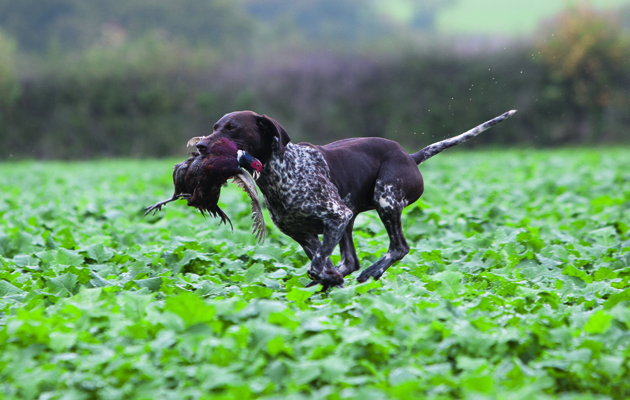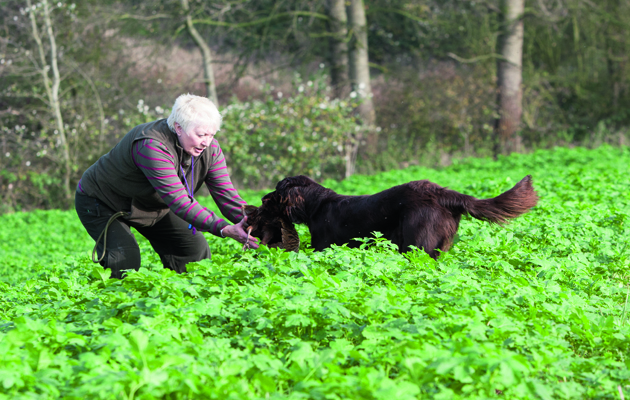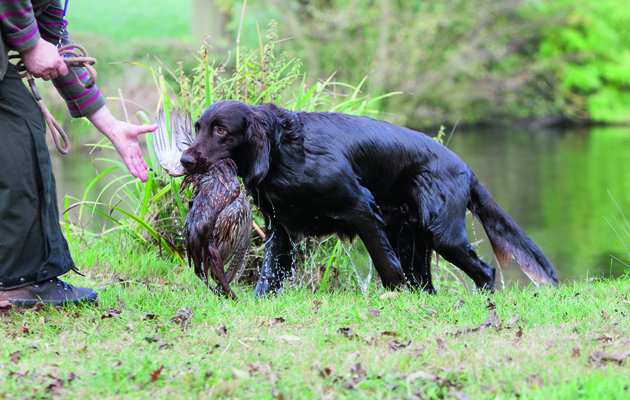Win CENS ProFlex DX5 earplugs worth £1,149 – enter here
Continental pointers in action

It was over 25 years ago when I first saw an HPR (hunt, point, retrieve) pointer working. I was photographing a spring pointing test and the dog was a German shorthaired pointer called “Basil.” I can clearly remember him casting out over a field of winter wheat, he was running flat out and he suddenly flashed round and stopped in an instant on point. The handler walked up to him and gave him the command to flush and a covey of partridges burst from the cover. It was a spectacular sight.
Although one of the Continental pointing breeds may not be the first choice of gundog for the majority of handlers, plenty of them are working in all aspects of the shooting field. They are a very versatile group of dogs, suited to rough shooting, picking-up and deerstalking. I have also seen plenty sitting at a peg during a driven day.
I recently joined Brenda Moss of the German Longhaired Pointer Association (Proposed) and a group of HPR enthusiasts on a shot over day in Warwickshire. The day was organised mainly to enable some young dogs to gain experience in the shooting field under controlled conditions, but also present were some older dogs with their handlers. There was a variety of breeds, including four German longhaired pointers (GLP), a Hungarian Vizsla, a Large Munsterlander, a German shorthaired pointer (GSP) and a German wirehaired pointer (GWP). The interesting thing is that although these dogs all fall under the same breed category they do all work in a slightly different way. Let’s make it quite clear, working an HPR is not like working a spaniel or a Labrador. The main difference is that the pointer is expected to cover a wide beat, anything up to 100 metres either side of the handler, and as a spaniel handler that is nerve-wracking. Though there have been occasions when my cockers must think they are HPRs!

Brenda Moss with her German longhaired pointer “Greta.” This was her first retrieve under “live conditions.”
Fine first attempt
Before casting a dog off, an experienced HPR handler will take note of the wind direction and work their dog according to whether there is a “back wind” or a “cheek wind.” Brenda was the first in line to run her young GLP “Greta” and as the bitch was quite new to the shooting field she worked her into the wind. The ground was a large field of knee-high mustard and right from the off the dog covered the ground with plenty of pace. After quite a long hunt, she started to feather out on some airscent and came on point, but Brenda could tell from her body language the dog wasn’t 100 per cent sure of the bird’s location. “Greta” was encouraged on and a cock pheasant jumped and curled off to the right hand side. Fortunately, Larry Wilkes (Brenda’s partner) was covering that side of the dog’s beat and managed to kill the bird with his 28-bore. It wasn’t long before “Greta” was delivering the bird back to her handler. It was the dog’s first bird under “live” conditions and Brenda was quite rightly very pleased with the outcome. Although “Greta” is a young dog, she has already gained a fourth place at the Kennel Club Chatsworth Novice Working Test at 10 months old, from a card of nearly 30 older dogs. She was also shortlisted in the Gundog Group at a Gundog Championship Show at 15 months of age. Brenda and Larry have been involved with GLPs since late 1999 and although the longhaired is not the most common of the breed group, one has just won the HPR Championship, so that may well change.
Genetic advantage
We have all heard of the saying “it’s in the genes” and with Karen Saynor’s Large Munsterlander “Tulli” that is certainly true. She is the daughter of Karen’s Field Trial Champion “Ekko,” which incidentally was the first-ever FTCH Large Munsterlander. To the uninitiated, this breed may look like a very large spaniel or collie cross. In fact, this is a multi-purpose gundog, ideal for the rough shooter, with an excellent nose, staying power, and the ability to work equally well on land and in water. Like the GLP before it, this bitch covered the ground at a phenomenal rate and had a good point on a hen pheasant that proved quite hard to pin down. Later in the day, “Tulli” proved that not only can HPRs hunt they can also be trained to take hand signals, as Karen handled her out to a difficult blind retrieve some 100 metres across a rape field.
Of all the gundog breeds, the HPRs have not yet fully diversified in to show and working types, and Susan Northwood’s Hungarian Vizsla “Rudi” and Bradley Dymond’s German shorthaired pointer “Marsh” certainly prove the point. “Rudi” has achieved two Challenge Certificates (CC) and one Reserve CC and just needs one more win to become a show champion. However, this dog had a couple of top-drawer points and flushes in some very thick woodland and then made a nice job of retrieving a cock pheasant. He was also graded ‘excellent’ in the HPRGA Spring Pointing Test at Blenheim in April and won the Hungarian Vizsla Club of Great Britian’s Novice Gundog Working Test in September.
Bradley’s GSP “Marsh” is also a show winner with a number of first places. This dog in particular worked a very good pattern and although he didn’t have a bird shot for him while hunting, he did pick a very lively runner, which was making for the hills across a rape field.
During the day, the dogs had hunted in all types of cover, ranging from mustard and rape to scrubby woodland and overgrown ditches. Then, to test and show the dogs’ versatility, a water test was set up and each dog was given a seen retrieve with a shot. Once again, all dogs achieved this without any problems. Working any gundog can be fraught with ups and downs and David Forsyth had a nightmare with his GLP “Kite” on what should have been a simple and straightforward retrieve. The frustration and disappointment on David’s face was clear to see, yet just an hour later “Kite” pulled off a fantastic retrieve on a long loose bird, shot by Larry and in no time all had been forgiven. As they say, that’s gundog’s for you!
Related Articles
Get the latest news delivered direct to your door
Subscribe to Shooting Times & Country
Discover the ultimate companion for field sports enthusiasts with Shooting Times & Country Magazine, the UK’s leading weekly publication that has been at the forefront of shooting culture since 1882. Subscribers gain access to expert tips, comprehensive gear reviews, seasonal advice and a vibrant community of like-minded shooters.
Save on shop price when you subscribe with weekly issues featuring in-depth articles on gundog training, exclusive member offers and access to the digital back issue library. A Shooting Times & Country subscription is more than a magazine, don’t just read about the countryside; immerse yourself in its most authoritative and engaging publication.








